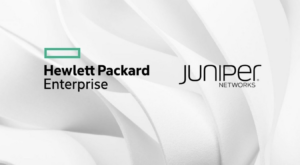Hewlett Packard Enterprise to acquire Juniper Networks in US$14bn deal
Edge-to-cloud computing giant Hewlett Packard Enterprise (HPE) is to acquire network technology company Juniper Networks in an all-cash transaction for US$40.00 per share that values the company at approximately US$14 billion.
 HPE said that the combination with Juniper advances its portfolio mix shift toward higher-growth solutions and strengthens its high-margin networking business, accelerating its sustainable profitable growth strategy.
HPE said that the combination with Juniper advances its portfolio mix shift toward higher-growth solutions and strengthens its high-margin networking business, accelerating its sustainable profitable growth strategy.
Upon completion of the transaction, Juniper CEO Rami Rahim will lead the combined HPE networking business, reporting to HPE President and CEO Antonio Neri.
Among their other activities, both companies are active in the media and entertainment space. HPE provides a range of content creation and workflow solutions. Its products also include the HPE Telco Video Headend Manager, which is designed to enable virtualisation of the video headend.
Juniper enables studio production workflows via its QFX5120 switch, while its MX Series 5G Universal Routing Platforms are used to power large broadcaster WANs. Its Mist AI solutions are also being used to build AI-driven studios. The company provides the global network for discovery+ among other clients.
Focus on AI
HPE said the acquisition would double its networking business, creating a new networking leader with a focus on expanding AI and hybrid cloud-driven business. HPE has been aligning its portfolio to evolve towards an AI-driven future with networking as a critical connective component, and Neri has previously said that getting on board with AI will mark a crucial inflection point for the business.
Juniper provides cloud-delivered networking solutions, software, and services including the Mist AI and Cloud platform. HPE said that the combination of these with HPE Aruba Networking and purposely designed HPE AI interconnect fabric would bring together enterprise reach, and cloud-native and AI-native management and control, to create a premier industry player that will accelerate innovation to deliver further modernized networking optimized for hybrid cloud and AI.
HPE said that on a pro forma basis, the new networking segment will increase from approximately 18% of total HPE revenue as of fiscal year 2023 to approximately 31% and contribute more than 56% of HPE’s total operating income.
HPE, which provides servers, storage and networking technology, was created as a result of the splitting up of the old Hewlett-Packard in two in 2015, with the legacy PC business remaining within the renamed HP Inc.
Juniper, a survivor of the original dot.com era of the 1990s whose core business is focused on routers, switches network management software and software-defined networking tech, last year announced a restructuring plan amid a pullback in spending by some of its biggest customers.
“HPE’s acquisition of Juniper represents an important inflection point in the industry and will change the dynamics in the networking market and provide customers and partners with a new alternative that meets their toughest demands. This transaction will strengthen HPE’s position at the nexus of accelerating macro-AI trends, expand our total addressable market, and drive further innovation for customers as we help bridge the AI-native and cloud-native worlds, while also generating significant value for shareholders. I am excited to welcome Juniper’s talented employees to our team as we bring together two companies with complementary portfolios and proven track records of driving innovation within the industry,” said Neri.
Our multi-year focus on innovative, secure AI-native solutions has driven Juniper Networks’ outstanding performance. We have successfully delivered exceptional user experiences and simplified operations, and by joining HPE, I believe we can accelerate the next phase of our journey. In addition, this combination maximises value for our shareholders through a meaningful all-cash premium. We look forward to working with the talented HPE team to drive innovation for enterprise, service provider and cloud customers across all domains, including campus, branch, data centre and the wide area network,” said Rahim.



